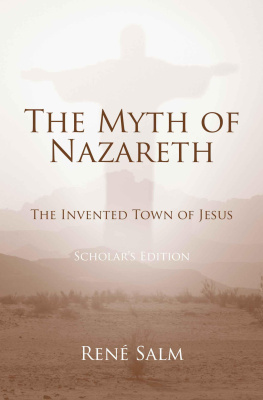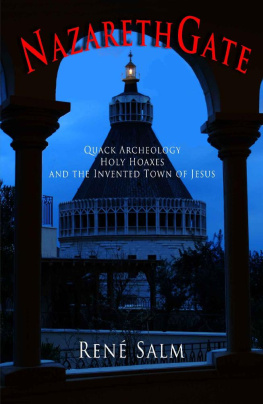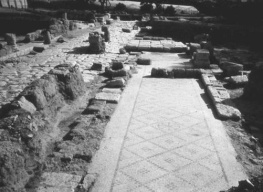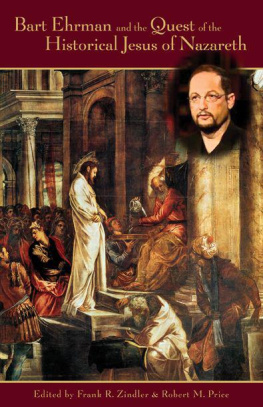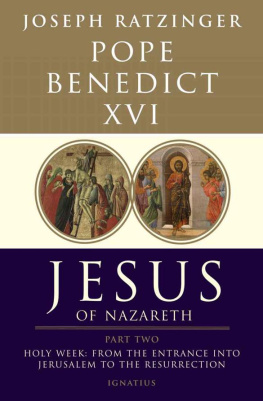P. O. Box 5733
All rights reserved. No part of this publication may be reproduced or transmitted in any form or by any means, electronic or mechanical, including photocopying, recording, or by any information storage or retrieval system, without permission in writing from the publisher.
Unless otherwise noted, the Scripture quotations contained herein are from the New Revised Standard Version Bible, copyright 1989 of the Division of Christian Education of the National Council of the Churches of Christ in the U.S.A., and are used by permission. All rights reserved. Photograph of Nazareth from the SE BibleWalks.com, used by permission. Photograph of Church of the Annunciation courtesy of gallery.tourism.gov.il.
Salm, Ren.
The myth of Nazareth : the invented town of Jesus / Ren Salm. -- Scholars ed.
p. cm.
1. Nazareth (Israel)--History. 2. Excavations (Archaeology)--Israel--Galilee.
3. Galilee (Israel)--Antiquities. 4. Jews--History--168 B.C.-135 A.D.
5. Jews--History--70-638. I. Title.
Introduction
This need is prevalent, in what must be construed as an irrational manner, that the archaeologists prove that all the events described in the Bible did indeed occur and that all the figures mentioned and the episodes described are entirely consistent with reality. There is in this demand a violation of archaeological integrity and an attempt to impose upon archaeology unattainable objectivesthat is, the proof of faith.
It is therefore not a coincidence that a considerable proportion of the archaeologists active in the Land of Israel over the past one hundred years have come from the religious establishment. Many of them received a large part of their education at various theological seminaries, while their archaeological training was often deficient. This is particularly evident among American archaeologists
This state of affairs has given biblicalarchaeology a reputation for amateurism in some archaeological circles. Modern scientific excavation is so complex that those who have not received adequate training (which is the case with most of those educated at theological seminaries) cannot conduct one properly.
Amnon Ben-Tor, The Archaeology of Ancient Israel (1992, p.9).
The archaeology of Nazareth fully corroborates Ben-Tors words. The early history of that hallowed ground is as unknown today as when digging first began, one hundred and fifteen years ago. Despite excavations conducted over many generations, mystery covers Nazareth like a blanket protecting a precious baby. In some circles, questions regarding the history of the village are unwelcome, as if the baby might be disturbed by too much probing. So, a venerable hush has settled over the place, a quiet acceptance in catholic circles that the mysterium verbi , and all associated with it, is beyond mans understanding.
No one really knows what happened at Nazareth two thousand years ago. Some scholars, uncomfortable with a posture of pure veneration, have attempted to peel back the blanket, at least slightly, only to confront a thick wall of tradition. Go no further! is the stern message conveyed to him who asks too many questions. Yet the questions multiply. Already in the nineteenth century some liberal scholars wondered why the town was not mentioned in the Jewish scriptures, nor in the Talmud, nor even once in the prolix writings of the first-century Galilean general, Josephus . The latter had, after all, lived in Japhia , a town less than two miles from Nazareth. Why, they asked, did the first Christian generations either completely ignore the place, or appear to not know where it was? The first writer to mention Nazareth (Julius Africanus, c . 200 CE) locates it in Judea. Again, why in the Acts of the Apostles (24:5), is Paul called a ringleader of the sect of the Nazoreans? Certainly he was not the leader of onetime inhabitants of Nazareth! Nazorean, these questioners opined, must once have referred to something other than a place. If so, then what was a Nazorean ( )? That term seems to be first used by Matthew, for Mark does not know itthe latter exclusively uses . In any case, English translations invariably read Jesus of Nazareth for both and . But was this the original meaning? Finallyfor these questions are without endwhy in his birth story does the evangelist Matthew introduce Nazareth with a perfectly unknown saying?
And he went and dwelt in a city called Nazaret, that what was spoken by the prophets might be fulfilled, He shall be called a Nazorean [ ]. (Mt 2:23)
No such text, He shall be called a Nazorean, exists in Hebrew scripture. Often called the most Jewish of the evangelists, Matthew was surely the least likely to make such an error.
From the Enlightenment until today scholars have questioned the historical foundations of the Christian religion. Some have even had the impertinence to deny that Jesus ever existed at all, at least as a flesh-and-blood human being (a few opine that Jesus was a spirit). Yet, mere opinion is weak, like a little water thrown against a wall. It will not bring down two thousand years of tradition. But, with demonstrable facts on its side and backed by science, a position rises above mere opinion. Though facts are fundamental, however, one should not suppose that they alone decide the issue, for everyone claims to have them. After all, in the realm of imperfect human discourse a fact is only that which is provable.
This is what gives the Nazareth issue such great potency. Unlike aspects of the gospel story that are quite beyond verificationthe miracles of Jesus, his bodily resurrection, his virgin birth, or even his human naturethe existence of Nazareth two thousand years ago can be proved or disproved by digging in the ground. Because the archaeology of a site is empirically demonstrable, Nazareth is in a category apart. To this day, it preserves the explosive potential to either prove or disprove the gospel accounts.
Upon that determination depends a great deal, perhaps even the entire edifice of Christendom. For more is involved here than the mere imputation of error to holy writ, grave as that may appear in conservative circles (though hardly new). Motive must also be considered. If Nazareth did not exist in the time of Jesus, then questions quickly arise: Why did the evangelists place him there? Was there something regarding his real provenance that they found objectionable? What was that provenance? If Nazareth was a persistent and recurrent invention in the gospels, then we leave the realm of error and enter the realm of elaborate fiction. This recognition would require a fundamental reappraisal of the Jesus story, and a paradigm shift in Christianity.
Most scholars summarily dismiss the invention of Nazareth on the grounds that the town is frequently mentioned in the Christian gospels. Unwittingly, archaeology is thus held hostage to literary considerations. The textual case for Nazareth in the gospels is much weaker, however, than is generally supposed. The settlement is named only once in the Gospel of Mark, at 1:9 (other instances in the Greek text read ). The passage as it stands demonstrably conflicts with the remainder of the gospel, which locates Jesus home in Capernaum. Thus, it can be shown that the Gospel of Mark contains the later interpolation of a single word, Nazaret at 1:9. Furthermore, the literary genesis of Nazareth occurs in one of the most problematic passages of Christian scripture, Mt 2:23 (cited above). For its part, the Gospel of Luke is equally problematic. It demonstrates a strident anti- Capernaum stance and the enigmatic scene in the Nazareth synagogue (Lk 4:1630) has been shown to be an elaborate reworking of prior materials.

